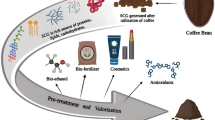Abstract
The removal of many synthetic fungicides from the market has created a demand for new, environmentally safe fungicides. Iturin A, a cyclic lipopeptide produced byBacillus subtilis, has strong antifungal properties and low mammalian toxicity. To determine the efficacy of this compound as a potential fungicide on stored feed grains, lots of corn, peanuts and cottonseed were treated with varying concentrations of iturin A. The mycoflora of treated seed was assayed along with that of untreated seed and seed treated with fungicides used commercially for planting seed. Fungal species varied considerably in their sensitivity to iturin A. Significant reductions in total mycoflora occurred in most seed lots tested at iturin A concentrations of 50 to 100 ppm.
Similar content being viewed by others
References
Delcambe L, Peypoux F, Guinand M, Michel G. Iturin and iturinic acids. Revue des Fermentations et des Industries Alimentares 1976; 31: 147–51.
Gueldner RC, Reilly CC, Pusey PL, Costello CE, Arrendale RF, Cox RH, Himmelsbach DS, Crumley FG, Cutler HG. Isolation and identification of iturins as antifungal peptides in biological control of peach brown rot withBacillus subtilis. J Agric Food Chem 1988; 36: 366–70.
Klich MA, Lax AR, Bland JM. Inhibition of some mycotoxigenic fungi by iturin A, a peptidolipid produced byBacillus subtilis. Mycopathologia 1991; 116: 77–80.
Blocquiaux S, Delcambe L. Essais de traitement de dermatomycoses par l'iturine. Arch Belg Dermatol Syphiligr 1956; 12: 224–26.
Bochow H.Bacillus subtilis T99, a biocontrol agent of soil-borne fungal diseases of greenhouse crops. In: Beemster ABR, Bollen GJ, Gerlach M, Ruissen MA, Schippers B & Tempel A, eds. Developments in agriculture and managed forest ecology, 23: Biotic interactions and soil-borne diseases. New York: Elsevier, 1991: 236–40.
Pusey PL, Wilson CL. Postharvest control of stone fruit brown rot byBacillus subtilis. Plant Disease 1984; 68: 753–56.
Blakeslee AF. Linder's roll tube method of separating cultures. Phytopathology 1915; 5: 68–9.
Hocking AD, Pitt JI. Dichloran-glycerol medium for enumeration of xerophillic fungi from low moisture foods. Appl Envir Microbiol 1980; 39: 488–492.
Klich MA, Pitt JI. A laboratory guide to commonAspergillus species and their teleomorphs. North Ryde, NSW, Australia: Commonwealth Scientific and Industrial Research Organization, 1988.
Nelson PE, Toussoun TA, Marasas WFO.Fusarium species: An illustrated manual for identification. University Park, PA: Pennsylvania State University Press, 1983.
Pitt JI. A laboratory guide to commonPenicillium species. North Ryde, NSW, Australia: Commonwealth Scientifica and Industrial Research Organization, 1988.
Steel RGD, Torrie JH. Principles and procedures of statistics, 2nd ed. St. Louis, MO: McGraw-Hill, 1980.
SAS Institute Inc. STA/STAT user's guide version 6, 4th ed. Vol. 2. Cary, NC: SAS Institute, 1989.
Kimura N, Ono M. 1989. Republique Fransçaise Patent No. 2644038.
Klich MA, Lax AR, Bland JM, Scharfenstein Jr. LL. Influence of iturin A on mycelial weight and aflatoxin production byAspergillus flavus andAspergillus parasiticus in shake culture. Mycopathologia 1993; 123: 35–8.
Ohno A, Ano T, Shoda M. Production of the antifungal peptide antibiotic iturin byBacillus subtilis NB33 in solid state fermentation. J Ferment Bioeng 1993; 75: 23–7.
Phae CG, Shoda M. Investigation of optimal conditions for foam separation of iturin, an antifungal peptide produced byBacillus subtilis. J Ferment Bioeng 1991; 71: 118–21.
Latoud C, Peypoux F, Michel G, Genet R, Morgat JL. Interactions of antibiotics of the iturin group with human erythrocytes. Biochem Biophys Acta 1986; 856: 526–35.
Latoud C, Peypoux F, Michel G. Interaction of iturin A, a lipopeptide antibiotic, withSaccharomyces cerevisiae cells: Influence of the sterol membrane composition. Can J Microbiol 1990; 36: 384–389.
Author information
Authors and Affiliations
Rights and permissions
About this article
Cite this article
Klich, M.A., Arthur, K.S., Lax, A.R. et al. Iturin A: A potential new fungicide for stored grains. Mycopathologia 127, 123–127 (1994). https://doi.org/10.1007/BF01103068
Received:
Accepted:
Issue Date:
DOI: https://doi.org/10.1007/BF01103068




